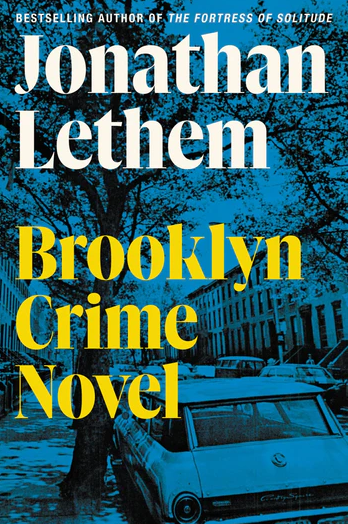Neighborhood kids weather the grittier parts of gentrification.

Years ago, when Manhattan colleagues learned that I lived in Brooklyn, they would ask what neighborhood and immediately guess Brooklyn Heights or Park Slope. When, as years went by, I answered Carroll Gardens or Midwood or Bay Ridge, they would stare at me blankly, then ask the question already in their eyes, “Why?”
Jonathan Lethem, of course, has done as much as anyone to change that dynamic, and Brooklyn is now the cool borough. His novels Motherless Brooklyn and The Fortress of Solitude chronicle life in neighborhoods that were once destitute but are now desirable. In Brooklyn Crime Novel, he illustrates what that transition cost the children of those neighborhoods.
The neighborhood in question, where Lethem grew up, is the main character in Brooklyn Crime Novel — the development around two blocks of Dean Street. And it gets a name, albeit one invented by real-estate interests: Boerum Hill (although there is no hill and little connection to the 18th-century Boerum family farm). The human characters in this complex and stunningly creative novel simply get descriptors like “the Dean Street boys” or “the younger brother.” Some get nicknames, like the Wheeze or Little Man, while one important figure gets an initial, C.
Lethem is not concerned with real estate but rather with gentrification and how it has steered the lives of the children living through it. Brooklyn Crime Novel follows the adventures of the (mostly) boys of the neighborhood — kids who didn’t choose to take part in this urban reclamation, who were not concerned with brownstone authenticity, original detail, or working fireplaces but with going to school, making friends, growing up, and surviving the violence and humiliation of this world their parents chose for them.
The story is told in brief anecdotes, jumping through time between 1976 and 2019 — a period Lethem describes as after the collapse of the Civil Rights Movement. The move to Boerum Hill was supposed to be an affirmation of integration, a rejection of the white flight decimating American cities. But the newcomers refer to themselves as “pioneers” and are deaf to the racism and classism inherent in that word. They think their children will be “ennobled” by having Black friends. Of course, children are neither ennoblers nor forces of social change — they are children, and they act out of the same impulses of fear and power and pride and humiliation that motivate adults. Very little ennobling goes on in these pages.
While the crimes of the title include questionable parenting, real-estate speculation, and lousy decorating, Lethem centers most of the action around a social ritual he calls “the dance.” In “the dance,” boys (and some girls) in their mid-teens intimidate and humiliate boys (and some girls) in their preteens into handing over money or property. These are not exactly muggings — the perpetrators do not demand money; they simply ask for it. The older boys only imply violence by their presence, their age, their size. And their race.
The older children are mostly Black and Latino, many coming over from the nearby housing projects, while their victims are mostly white. The children live out the changing ownership and future of the blocks as the dance reverses the power dynamic taking over the neighborhood — those older kids are part of the problem that the white newcomers are there to solve. The not-quite-robbing practice is widespread and well-known enough that parents send their children out with “mugging money,” a dollar in the pocket to hand over, real cash hidden in the shoes. These kids live an aspect of gentrification that doesn’t make the real-estate ads.
As the neighborhood grows more prosperous, the characters age and develop. They outgrow the dance. They leave the neighborhood for high school. Many of the white boys find their way to New York City’s elite schools — both private and public — and the center of their lives moves from Dean Street to Manhattan and beyond. The dancers become computer geeks, graffiti artists, booksellers, and, yes, novelists. One even becomes the Wheeze. Aging itself is indicted, made criminal as characters carry the scars of their predatory childhood. They fall victim to nostalgia in their search for redemption.
Having gone back to the old neighborhood in his more conventional novels, Lethem offers anything but convention here. He discusses his themes and lays out his ideas more directly than authors generally do. Brooklyn Crime Novel will strike some as speculative sociology or meditative history more than fiction. And while the incidents and anecdotes are compelling and funny, the book sometimes feels too long — the jumble of chronology and humiliation goes on long after the reader has gotten the point. In many cases, that’s fine — a good anecdote can be self-justifying — but endurance becomes another demand Lethem makes of the reader, and the didactic and spontaneous tone of the book are already demanding.
However, there is joy in being in masterful hands, and the way Lethem’s chronology balances chaos and forward movement, not to mention the deftness of his detail, brought me great joy. Not everyone will relate to Boerum Hill as fervently as Lethem does, but gentrification and race, childhood and memory, redemption and nostalgia are not unique to Brooklynites. We just think they are.
John P. Loonam has a Ph.D. in American literature from the City University of New York and taught English in New York City public schools for over 35 years. He has published fiction in various journals and anthologies, and his short plays have been featured by the Mottola Theater Project several times. He is married and the father of two sons; the four have lived in Brooklyn long enough to be considered natives by anyone but his neighbors.

